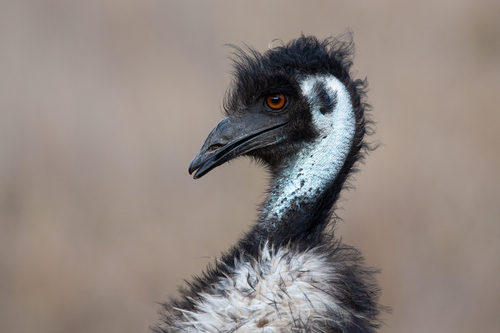
Emu
The Emu (*Dromaius novaehollandiae*) is the second-largest living bird by height, after the ostrich. Endemic to Australia, it plays a crucial role in the ecosystem as a seed disperser. Emus are culturally significant, appearing in Aboriginal mythology and on the Australian coat of arms. They are known for their distinctive booming calls and curious nature, making them a recognizable symbol of the Australian outback.
150-190 cm
Length
Vestigial cm
Wingspan
Least Concern
Conservation Status
Distribution
Emus are found exclusively in Australia, ranging across most of the mainland. They avoid dense forests and heavily populated areas, preferring open plains and sclerophyll forests.
Lifespan
10-20 years in the wild; up to 35 years in captivity.
Emu's Habitat
Habitat Types
Savannas, Grasslands, Sclerophyll forests, Semi-arid plains
Climate Zones
Temperate, Subtropical, Arid
Adaptations
Emus have strong legs and feet, enabling them to traverse long distances and run at high speeds across varied terrain. Their feathers provide insulation against both heat and cold, crucial for survival in Australia's diverse climates.
Variations
While there used to be several subspecies, including dwarf forms on Tasmania and King Island, these are now extinct. The mainland Emu is now considered the only extant subspecies.
Appearance
Breeding Plumage
No significant difference between breeding and non-breeding plumage.
Seasonal Feather Changes
Minimal seasonal variation; chicks have striped camouflage.
Sex Based Plumage Differences
Minimal; males and females have similar shaggy, brownish-black plumage.
Notable Features
Long, powerful legs with three forward-facing toes., Vestigial wings, hidden beneath their plumage., Soft, brown feathers that appear shaggy., Dark blue or black skin on the neck and head.
Diet and Feeding
Primary Foods
Seeds, Fruits, Flowers, Insects, Young shoots, Small animals
Foraging Behavior
Emus are primarily diurnal, foraging for food during the day. They peck at food items on the ground and can cover large distances in search of food.
Specializations
Emus have a large gizzard that helps them grind up tough plant material. They also swallow small stones (gastroliths) to aid in digestion.
Seasonal Diet Variations
Their diet varies depending on food availability. During drier periods, they may consume more dry vegetation and seeds, while in wetter seasons, they may eat more fruits and insects.
Behavior
Social Structure
Generally solitary or in pairs, except during breeding season and when young are with the male. Non-breeding birds may form loose aggregations.
Communication
Booming calls (females), Drumming and grunting sounds (males), Hissing (defense), Visual displays, such as raising and lowering their neck feathers.
Migration
Emus are not migratory in the traditional sense, but they are nomadic, moving to areas with better food and water availability.
Territorial or Group Behaviors
Males become highly territorial during breeding and chick-rearing. Outside of the breeding season, they are generally non-territorial.
Conservation
Threats
Habitat loss and fragmentation due to agriculture and development., Vehicle collisions., Predation by introduced species (e.g., foxes, feral dogs) on chicks and eggs., Climate change, leading to increased frequency and severity of droughts.
Protection Programs
Emu farming for meat, leather, and oil., Habitat restoration and management in some areas.
Local National Laws
Protected under state and territory legislation in Australia. Permits are required to keep or farm Emus.
Population Trend
Stable
Population Estimates
Estimated at 630,000 to 725,000 individuals.
Interesting Facts
Emus can run at speeds up to 50 km/h (31 mph).
Their powerful legs allow them to escape from most predators.
The Emu's deep booming call can be heard up to 2 km (1.2 miles) away.
This call is produced by an inflatable neck sac.
Emu eggs are large and dark green, weighing around 450-650 grams.
The color provides camouflage in the nest.
Emus are good swimmers.
They can cross rivers and even swim in the ocean.
Faqs about Emu
Are Emus dangerous?
Emus are generally not aggressive towards humans unless provoked. However, they can deliver powerful kicks with their sharp claws, so it's best to admire them from a safe distance.
Can Emus fly?
No, Emus are flightless birds. Their wings are vestigial and too small to support flight.
What is the purpose of Emu farming?
Emus are farmed for their meat, leather, and oil. Emu oil is believed to have medicinal and cosmetic properties.
What eats an Emu?
Adult emus have few natural predators, but dingoes, wedge-tailed eagles, and goannas might prey upon them or their eggs. Introduced species like foxes and feral dogs pose a greater threat, especially to chicks.
Copyright @ Nature Style Limited. All Rights Reserved.
 English
English